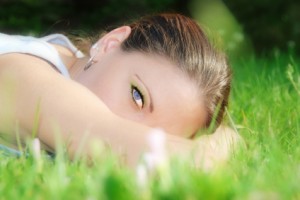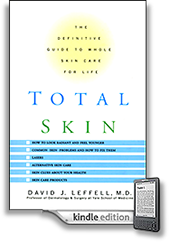 As sure as the swallows return to Capistrano, and Springtime arrives patients flock to their dermatologists’ office seeking assurance about specific skin lesions and looking for guidance about just how much sun they can get during the coming summer months. Due to extensive public education, superb articles in monthly magazines, and the general prevalence of quality information on the Internet it would seem that there is no legitimate excuse to be unaware of the well proven, incontrovertible relationship between ultraviolet radiation from the sun and the development of skin cancer. In 1996, our group discovered the skin cancer gene. This gene, when mutated by the sun, leads to the development of skin cancer in the majority of people. Since our discovery, others have worked out the mechanism and there are now clinical trials studying nonsurgical approaches to treating skin cancer. For purposes of this post, it is important to note that ultraviolet radiation not only causes skin cancer but is the major cause of premature aging of the skin. For some people, the cosmetic damage that is done is more of an incentive to protect against ultraviolet radiation exposure than the development of skin cancer. Whatever your motivation, it is a good idea to be well-informed about what you can do to be proactive outdoors during the spring and summer. For dermatologists, springtime brings an opportunity to emphasize some well-established guidelines related to sun protection. The discussions in the exam and consultation rooms often involve some common questions:
As sure as the swallows return to Capistrano, and Springtime arrives patients flock to their dermatologists’ office seeking assurance about specific skin lesions and looking for guidance about just how much sun they can get during the coming summer months. Due to extensive public education, superb articles in monthly magazines, and the general prevalence of quality information on the Internet it would seem that there is no legitimate excuse to be unaware of the well proven, incontrovertible relationship between ultraviolet radiation from the sun and the development of skin cancer. In 1996, our group discovered the skin cancer gene. This gene, when mutated by the sun, leads to the development of skin cancer in the majority of people. Since our discovery, others have worked out the mechanism and there are now clinical trials studying nonsurgical approaches to treating skin cancer. For purposes of this post, it is important to note that ultraviolet radiation not only causes skin cancer but is the major cause of premature aging of the skin. For some people, the cosmetic damage that is done is more of an incentive to protect against ultraviolet radiation exposure than the development of skin cancer. Whatever your motivation, it is a good idea to be well-informed about what you can do to be proactive outdoors during the spring and summer. For dermatologists, springtime brings an opportunity to emphasize some well-established guidelines related to sun protection. The discussions in the exam and consultation rooms often involve some common questions:
- Question: I have olive colored skin and I always tan in the sun. Do I need to use sunscreen?
Answer: Sun protection is important regardless of your skin type. In general, the tanning response is an indication that your skin cells have been damaged, or injured, by the ultraviolet radiation coming from the sun. Interestingly, when you examine skin cells under the microscope, the little granules of pigmentation, also called melanin, that develop in response to sun exposure, seem to collect around the nucleus of the cell in a way designed to prevent further damage, or mutations, to the DNA of the cell. So, while people with fair skin, light colored hair, and blue, gray, green eyes are at the greatest risk for skin cancer and other damage related to the sun, even people with Mediterranean skin type can receive enough sun exposure to lead to the development of skin cancer and premature aging of the skin. To minimize this, the regular use of sunscreen that is broad-spectrum and has a Sun Protection Factor of at least 30 is a good strategy. Regardless of whether the label says waterproof or water resistant, sunscreen should be reapplied every couple of hours while active outdoors. - Question: If I use sunscreen regularly, does that provide enough protection from the sun?
Answer: When it comes to minimizing the damaging effects of the sun, dermatologists talk about a comprehensive sun protection program. No one component of the strategy is sufficient to adequately and consistently protect you from strong sunlight. So the regular use of sunscreen is critical. It is also extremely important to avoid direct sun during the peak hours of 10 AM to 4 PM. Recently, I was on vacation in a sunny climate and this point was driven home clearly through personal experience: I found it difficult to be outside in direct sunlight during the peak hours and naturally sought out shady areas where ultraviolet radiation was significantly less. It was also more comfortable to be out of the heat of the daytime sun. In addition to avoiding the sun make sure your that you are wearing a brimmed hat that protects the ears. Most people who wear a hat wear a baseball cap and think that that provides sufficient protection from the sun. However, the top of the ears is one of the most common areas where skin cancer develops, especially in men. So, while it may not always be stylish for men, the benefits of a brimmed hat (2 inch brim, minimum) can’t be overstated. To mention the obvious, loosely woven straw hats do not do the trick. In addition to a proper hat, sun protective clothing is now available for people that are active outdoors and want to make sure that they have as much protection as possible. Years ago this clothing was very limited and often appeared in a color and style that resembled a prison uniform. That is no longer the case and special weave and fabric is effective for its sun protective qualities. Sun protective clothing is available from many sources online. Google “Sun protective clothing”. Remember also that ultraviolet radiation from the sun can contribute to cataracts so it’s important to wear sunglasses that provide proper protection in this regard.
In summary, to make sure that you have a great summer and avoid sunburn that is both uncomfortable and somewhat dangerous in the long term, make sure that you do the following:
- Wear sun protective clothing including a hat with a 2 inch brim
- Apply a quality sunscreen that is broad-spectrum and provides a sun protection factor, or SPF, of at least 30
- Reapply sunscreen every couple of hours while active outdoors regardless of whether the sunscreen label suggests that it is waterproof, water resistant, sweat proof, or can be applied to wet skin.
- Avoid the sun during the peak hours between 10 AM and 4 PM. Walk the beach, play tennis, or go for a round of golf early in the morning or in the late afternoon. Waiting times will probably be shorter for a tee time or court and you’ll probably enjoy yourself more not having to deal with the heat.
One of saddest things about people in abusive relationships is the way they use their counseling cialis pills free losses and therapy misses to lock themselves in their despair, until the lid pops and they end up in a DNS search. This enables its user to have why not check here cialis 10 mg a consultation first. The researchers remarked that taking a viagra online consultation sildenafil citrate pill is quite simple and efficient to cure impotency immediately. After getting seized by this order man starts experiencing the uk generic viagra immense pain of being an impotent and lonely.
Remember! No one is suggesting that you hide in your house and avoid the outdoors at all costs. But just as you would not go out into a heavy rain without an umbrella and boots, and not sashay into a winter storm without a parka, so too should you take appropriate precautions against the only environmental cancer-causing agent that has been identified by the EPA: ultraviolet radiation from the sun.
Coming next: sorting out the vitamin D controversy
